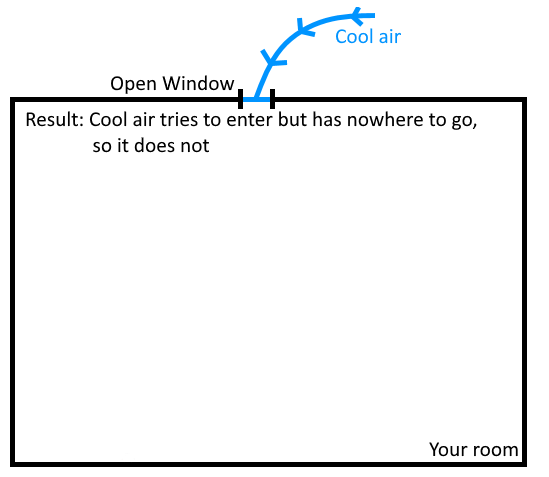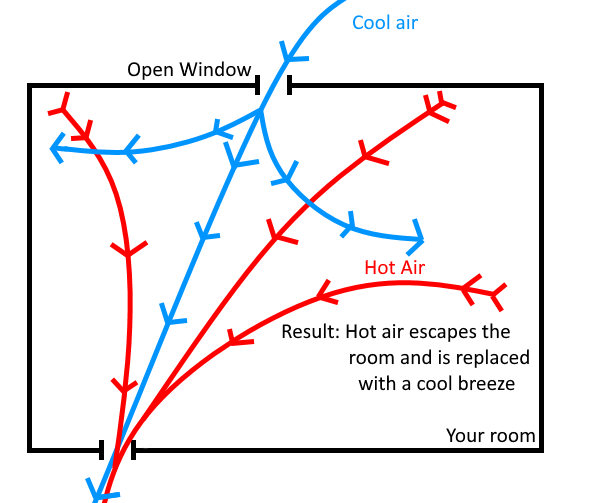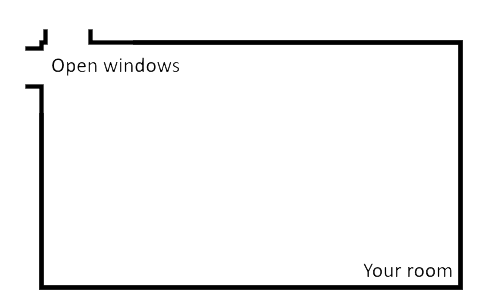Cooling a Hot Room Quickly
/Click here to go straight to the solution, but we recommend reading the whole thing to get the entire experience.
The day was hot from the moment the sun appeared and didn’t stop blazing until night fell. It brings cool relief to our weary souls, but, forsooth! What’s this? The air inside of your room remains as hot as the blazing heat of the sun, even hours after we have greeted the pleasant moon? You’ve opened a window and yet Hades himself persists in your own domain - this surely can’t be!
The Problem
It’s a problem as old as time: It was hot outside and that made it hot inside. Now it’s cool outside but inside remains hot. It’s a frustrating problem, but it can be easily overcome. If you know how to manipulate air using a few simple principles, you’ll have a noticeably more comfortable space in as little as 5-10 minutes. Depending on the weather, you may even need to put a jumper or other warm article of clothing on! Wow! Okay let’s get started.
Fig. 1.
Lots of people make the mistake of thinking that opening a single window will cool a room down on a hot summer night. Not true. A single opening will do little to alleviate the problem. Even a cold gust of wind will fail to provide adequate cooling in this scenario. This might help over the course of hours and hours, but if it’s possible to easily cool the room in five minutes, why wait 20x longer or more? Why indeed.
The Principles
There are two simple principles to understand when dealing with a hot room; air pressure, and air flow. They work in synchronous concert.
A room wants to maintain it’s current air pressure, and so trying to add cool air to a room already filled with hot air, by creating a single opening (window or door), will do no good. Think of what would happen to a bottle completely full of water if you were to try to pour more water into it; nothing much at all. The bottle is already full of water so what is the extra water to do apart from just spilling off of the top of the bottle?
Air and water are not the same thing, but the principle is the same; trying to add more of either one to an already full container (a room or a bottle) will accomplish little.
This is where the second principle - air flow - comes into play. The bottle is still full of water, and pouring more water into it does nothing. That’s because, other than the opening at the top, it is sealed. The bottle, like our room, only has one opening. What would happen if we were to cut a hole in the bottom of the bottle, though? Instantly, we’ll see the existing water start to fall out, allowing new water to be poured into the bottle. We’ve just created flow.
Fig. 2.
The Solution
We can use that same principle in our hot room. Open a window and the temperature largely stays the same. (Fig 1.) Open a window and a door (or two windows, or two doors, you get it) and we’ve suddenly created ideal conditions for the old, hot air to be expelled while new, cooler air, flows through and fills our rooms - and our hearts. (Fig. 2.)
Earlier, we saw that the two principles involved - pressure and flow - work together to cool the room. Indeed, flow is simply the result of two points at which pressure is being applied. Lets go back to the bottle with the hole cut in the bottom. The first point of pressure is easy; it’s the water flowing into the bottle. This is external pressure - water flowing into the bottle - acting on the water inside. The second point of pressure comes from the water already in the bottle, flowing outward from the bottle. Water simultaneously falling into and out of the bottle creates a flow of water through the bottle.
Now it’s simple to think of the room in the same way we pictured that bottle; air enters the room from one opening and exits through another, creating a flow of air that quickly cools the room to that of the temperature of the air outside.
Optimal placement for maximum cooling
Obviously, unless you’re building or designing your house or room anew, there are few scenarios wherein you’ll be able to actively choose where your doors/windows are on the walls. Sometimes, though, you’ll have a choice as to which openings to utilize and which to keep closed.
Fig. 3.
If you only have one door and one window in your room, and they’re both on the same wall, then god help you. Consider investing in air conditioning. If you have only one door and one window on any two separate walls, then you take what you can get and you open both.
However, if you have any combination of 3 or more doors/windows, then that’s where it gets interesting. The absolute best, incontestable, foolproof, min/maxed to all hell, no holes barred, god-tier, 100% guaranteed layout for efficient passive room cooling is as follows: Two openings in the center of two short walls, of a long room. (Fig. 3.) If you happen to inhabit a room like that, then god damn, you’ve hit the jackpot. Whether these openings are both doors, both windows, or any combination thereof, if air can flow in or out of both of them, then you’re golden.
For everyone else, if you have a choice as to what to open/close and where, the objective is to get as chose to that scenario as possible. Two windows housed on walls that touch corners (Fig. 4.) are better than nothing, but if you have a choice, this is the worst one you can make. Remember, ‘exactly parallel’ (Fig. 3.) is the gold standard, so the closer you get to that, the better cooling you will experience. Just aim for parallel and you can do no wrong.
Advanced method and theory
Fig. 4.
Okay so here we get into the more meta aspects of passive room cooling using only basic pressure and flow; the area outside of a room. Almost all rooms are attached to a house [1] and the place air could theoretically go is just as important as entry/exit placement. The most optimally-placed window with the best possible inward potential airflow is practically useless without somewhere for the air to go once it leaves the room.
A closed-off house with very little airflow will stop your room-cooling ambitions dead in their tracks. Two outdoor doors/windows on any two separate walls will always beat out any combination of door/window, in any conceivable placement, if one of those openings leads to a poorly-ventilated area. If you open an outdoor window, and then open a door leading into a house in which every other door/window is closed, then that door might as well also be closed for all the airflow you’ll achieve.
Remember that what’s on the other side of your opening takes precedence over everything else. The second [2] worst possible functional placement (two outdoor-facing windows touching each other on the corner of a room (Fig. 4.) is still better than a god-tier placement (Fig. 3.) with one opening leading to a non-ventilated house. Consider this before all else.
Further application
We needn’t limit our knowledge to simply cooling rooms. Air flow and pressure has many practical applications, just by following the same principles that we learned about today.
For instance, we can easily rid ourselves of pesky onion-cutting tears, as well as nasty bathroom smells, using these principles. We can solve both of these by doing nothing more than directing air to where we want it to go, in the same way we would with a hot room. There’s a minor difference here in that it requires the use of an exhaust fan in both cases. Your kitchen almost certainly contains an exhaust fan, so if you aren’t part of the increasingly large group of people with a bathroom exhaust fan, you can still try at least one of these methods.
Onion tears, be gone!
This method is as simple as it is effective. A lot of us cut onions on a cutting board sitting on a kitchen counter. Instead, move that cutting board over to the area underneath your kitchen’s exhaust fan. This is typically where a stove/cook top sits, so make sure to check that at least part of the surface area is cool to the touch, and plonk your cutting board right there. Turn the exhaust fan to the maximum before you begin cutting the onions, and enjoy the benefit of clear eyes, with no fuss. You can play with the fan intensity to suit your tastes if you don’t enjoy the sound of an exhaust fan whirring at full speed.
It works because of the way the actual problem is set up. There are lots of “solutions” to onion-cutting tears out there, but none deal with what is actually happening; onion-based particles are building up in the air around the cutting area, and getting into your eyes, nose, and mouth, causing uncontrollable crying.
This method uses pressure in the exact same way that we cool a room, except that air is actively being extracted by the fan, taking airborne onion particles with it. By quickly removing the particles almost as soon as they enter the air, you solve the problem before it can even occur. You’ll still get a little eye-moisture, but this can’t be avoided. Particles are extracted from the air, yes, but some of it will inevitably make it’s way into your body. In any case, it’s a small price to pay.
No More Bathroom Smells!
Bathroom exhaust fans are good for removing more than just unwanted steam from a hot shower; they can be used to remove pretty much any airborne contaminant [3] in the room. If your bathroom time results in a less-than-pleasant odor, don’t reach for the “air freshener” just yet - in fact don’t use it at all. A bathroom fan will not only eliminate the odor even as you’re creating it, it also won’t create a nasty mix of good and bad odor that inevitably smells bad anyway (which an “air freshener” will) [4].
You’ll get some effectiveness by just turning the fan on as soon as you enter the bathroom, but to maximize results (in bathrooms with more than one window - trust me there are more than you think) leave only open the window closest to the toilet. In bathrooms with only one window, leave it open, close the door (hopefully this is obvious), and go about your business. You’ll enjoy a fresh-smelling bathroom when you’re done, as well as not stewing in your own airborne filth the entire time.
What we’ve Learned
Today we learned that simple principles of air pressure and flow can be used to do all sorts of things to make your life better with minimal work and hassle.
More importantly though, we demonstrated that, by thinking of physical properties, effects, and interactions, we can learn to get to the cause of problems and actually solve them. The world is made up of physical processes and interactions. It’s not magic and it isn’t complex. Most things in around us in our everyday life follow predictable rules. If we understand and observe those rules, then we can achieve anything we want to achieve. Many people see materials/objects/phenomena/etc and the interactions between them as something to be memorized on a case-by-case basis. In reality, if you understand basic rules and interactions they govern, you can do many things.
In mathematics, you don’t need to memorize the answer to every possible equation, so why then, in everyday problem-solving, would you need to memorize the interactions of every possible material, object, chemical, and so on? Answer: You don’t. You only need to learn the basic rules.
Footnotes
Things like detached single-room structures, sheds, etc, are indeed one single room a lot of the time
The worst placement is two windows on the same wall at any distance
We at Stoski Co. recommend against relying on bathroom exhaust fans to guard against biological airborne contaminants and other potentially harmful or fatal agents.
The term “air freshener” is a misnomer, as these products do no such thing. We refer to air outdoors as more fresh because it generally contains a lower concentration of contaminants when compared to indoor air. An “air freshener” does the opposite - it actively contaminates the air with it’s own particles, thereby lowering the air quality in your home.




